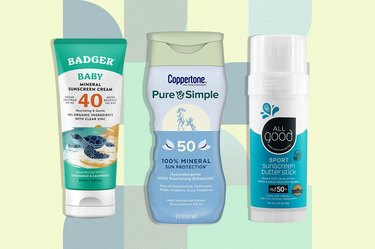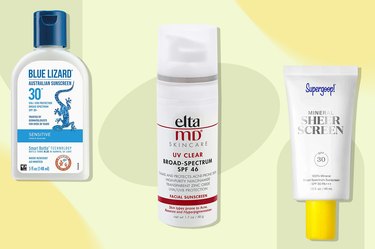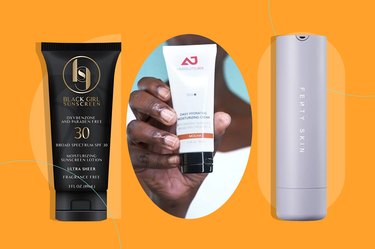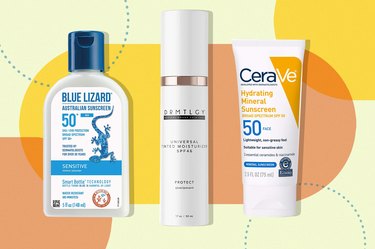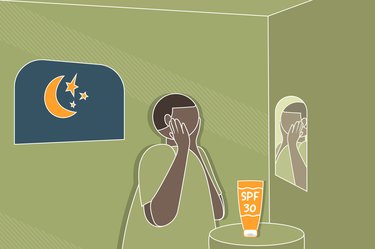
Sunscreen is a daily skin-care staple (at least it should be, hint hint), and it plays a major role in the fight against skin cancer.
Buying the right sunscreen for your skin and lifestyle needs is the first step toward getting the best coverage. But you also need to apply it correctly to truly keep your skin safe in the sun.
Video of the Day
Video of the Day
Here, two dermatologists explain the most common sunscreen mistakes and how to avoid them.
Mistake 1: You're Choosing the Wrong SPF
You've probably noticed the term SPF in big, bold letters on every sunscreen bottle. If you've ever wondered what it actually means, it stands for "sun protection factor," says Bruce Robinson, MD, a board-certified dermatologist in New York City.
SPF comes in different amounts, with 15, 30 and 50 among the most common. In short, it's a measure of how well the product protects you from the sun, including how well it blocks UVB rays, which cause sunburn.
For example, SPF 30 allows about 3 percent of the sun's UVB rays to hit your skin, while SPF 50 lets about 2 percent of these rays through, according to the Skin Cancer Foundation.
The higher the SPF, the higher the protection against sunburn and skin damage, which can lead to skin cancer.
That's why it's important to choose a sunscreen with at least SPF 30, according to the American Academy of Dermatology (AAD). And make sure the bottle says it offers "broad-spectrum" protection, which means it protects against UVB and UVA rays (the latter is associated with skin aging, per the Skin Cancer Foundation).
Finally, there's no such thing as "waterproof" sunscreen, but if you're going to be sweating or spending time in the water, make sure to reach for a water-resistant sunscreen.
Mistake 2: You're Not Applying Enough
You're probably not using nearly enough sunscreen to really reap the benefits.
Dr. Robinson says the ideal amount of sunscreen lotion for full-body coverage is an ounce (that's enough to fill a shot glass).
Sunscreen should be applied to all skin that isn't covered by clothing at least 15 minutes before going outside, according to the AAD.
Tip
If you're using spray sunscreen, make sure to spray your skin until it glistens and then rub in the product with your hands for full, even coverage, per the AAD. Don't spray your face — instead, spray the sunscreen into your hands and then rub it into your face.
Mistake 3: You're Only Using Sunscreen On Your Face
Wearing sunscreen is one way to maintain your skin's health and prevent premature skin aging, but it has to be applied to more than just your face.
In fact, melanoma (the most serious type of skin cancer) most commonly occurs in the lower legs for women and upper back for men, Dr. Robinson says. "Using sunscreen [on these areas] can prevent that."
Mistake 4: You're Using Expired Sunscreen
Did you know sunscreen expires? And there's good reason to pay attention to its expiration date.
Using expired sunscreen can affect how much sun protection your skin is getting, says Maral Skelsey, MD, a board-certified dermatologist and director of the Dermatologic Surgery Center of Washington. Meaning: You're more likely to get burned.
"Sunscreen is meant to last three years," Dr. Skelsey notes, but keep in mind that's three years from the manufacture date, not three years from the time you buy it.
If a bottle is past its prime, toss it and buy a new one to make sure you're getting full coverage.
Mistake 5: You're Storing It in the Wrong Place
It can be handy to keep sunscreen in your car's glove box for application on-the-go or, say, on your sunny bathroom windowsill, where you'll be sure to see it each morning. But neither is a good idea.
Storing sunscreen in direct sunlight or in a hot environment will make its ingredients break down faster, per the AAD, meaning it's likely to become less effective even before its expiration date.
Instead, store sunscreen in a temperature-controlled spot away from direct sun, like a cabinet.
Tip
If you notice any changes in the color or consistency of your sunscreen (especially if it seems like the contents have "separated"), it's time to throw it out and buy a new bottle, per the AAD.
Mistake 6: You're Not Reapplying
Putting on sunscreen isn't a one-and-done process. If you're going to be outdoors for long periods of time, you need to keep reapplying it to maintain protection.
According to the AAD, you should reapply sunscreen every two hours when you're outside, or sooner if you're sweating (most water-resistant sunscreens are effective for somewhere between 40 and 80 minutes). Sunscreen should be immediately reapplied after swimming.
These recommendations are for sunscreen of any level SPF, for the record, so you can't skip reapplying even if you're using SPF 50 or higher.
"I'd try to reapply at least two to three times a day if you're really outside for longer periods of time," Dr. Robinson says.
Mistake 7: You Only Use Sunscreen on Hot, Sunny Days
On a cloudy, rainy day, you might be tempted to skip sunscreen because you don't see the sun, but don't be fooled: There are still powerful UV rays coming from the sun even when it isn't visible, per the AAD. (Yes, even when it's cold outside!)
Sunscreen should be worn during the day every time you go outside, even on cloudy days. Just because it looks like the sun is taking a break doesn't mean you should let your guard down.
Mistake 8: You're Only Relying on Sunscreen for Sun Protection
While sunscreen is a great defensive tool for your skin, it shouldn't be the only thing you're using for sun protection. Other items that should be in your arsenal include sun-protective clothing, sunglasses with UV protection and wide-brim hats, Dr. Robinson says.
"You should also try to avoid the sun between the hours of 10 a.m. and 3 p.m., when it's at its highest," he adds.
Is this an emergency? If you are experiencing serious medical symptoms, please see the National Library of Medicine’s list of signs you need emergency medical attention or call 911.
